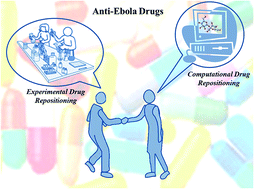Discovery of anti-Ebola drugs: a computational drug repositioning case study†
Abstract
Computational drug repositioning has complemented and guided the experimental drug repositioning assignments in the recent past. Structure- and ligand-based strategies have been tried for the generation of novel repositioning ideas. In the present computational work, an attempt has been made to reposition a set of approved/existing drugs as novel anti-Ebola agents, targeting VP35 viral protein. One of the crystal structure ligands bound to VP35 protein was used as a query for the initial shape- and electrostatics-based virtual screening using OpenEye Scientific Software suite. The top-ranking hits from the ligand-based virtual screening were further docked in the ligand-binding pocket of the VP35 protein. The virtual hits from both the ligand- and structure-based screening were examined carefully in terms of tightness of their binding interactions with the macromolecular target. Several top hits belonged to therapeutic categories like antidiabetics (e.g., nateglinide), antihypertensives (e.g., telmisartan) and antibiotics (e.g., ticarcillin), etc., totally unrelated to the proposed antiviral indication. The computational repositioning hypotheses generated at the end of this study are likely to interest several researchers around the globe that are desperately looking for a breakthrough treatment to curb the recent menace created by a relatively older virus. The proposed hits that are approved/existing drugs may serve as starting points for the clinical repositioning for anti-Ebola indication or as lead structures in fast-track anti-Ebola drug discovery campaigns.


 Please wait while we load your content...
Please wait while we load your content...